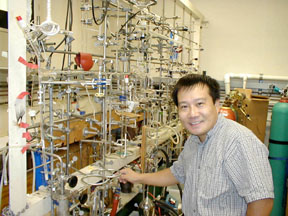geotimesheader
News
Notes
Ancient
clouds trapped in stone
In back-to-back reports, University of California, San Diego, scientists
have shown it is possible to wring out the chemical signatures of Earth’s
atmosphere from Precambrian stone. As they hunt down isotopic anomalies
never before seen in Earth’s rock record, the scientists are excited about
the future prospects of their technique.
“People have been looking for a way to track the evolution of oxygen
and the origin of life for at least 50 years and this is the first time
there’s ever been a quantitative way to do that,” says Mark Thiemens, dean
of physical sciences at UCSD.
Until now, analysis of ancient atmospheric signatures depended on the
depth of glacial ice. The oldest known ice core comes from Vostok, Antarctica,
where ice 3,000 meters deep provides some 400,000 years of history. But
a core extending beyond 300,000 years becomes highly compressed at its
base, making information difficult to extract, the scientists say.
| Turning to terrestrial rocks offers an easier, and sometimes warmer,
method for reading the longer story about Earth’s air. Reporting in the
Aug. 4 Science, James Farquhar, Huiming Bao and Thiemens pried atmospheric
secrets out of 3.8 billion-year-old rocks from Greenland; 3.4 billion-year-old
rocks from Australia and South Africa; and 700 million-year-old rocks from
Australia, China, Africa, Canada and the United States.
Farquhar and colleagues found multiple isotope variations of a kind
only recently considered possible in terrestrial solids: anomalous sulfur
ratios incorporated into the rocks after the rocks oxidize in air. Their
discovery pointed to a profound change in the sulfur cycle between 2.1
billion and 2.5 billion years ago, a time when Earth’s atmosphere is known
to have shifted from primitive, oxygen-poor conditions to an oxygen-rich
environment more like today’s. |

Huiming Bao hard at
work at the University of California,
San Diego. Photo courtesy
of James Farquhar. |
How much oxygen first flooded the skies is still up for debate and
Farquhar is investigating whether the change in the sulfur cycle will offers
clues. “We have to figure out what the atmospheric reaction was that produced
the effect,” he says.
Their research indicates that before 2.5 billion years ago, oxidation
of sulfur-bearing gases, which later incorporated into the sulfur and sulfide
minerals in the rocks, mainly originated from the limited oxygen in the
atmosphere.
During the critical period when oxygen and ozone began accumulating,
the sulfur cycle began to favor a varied contribution relying more on continental
oxidated weathering and microbial sulfate reduction.
In the past, scientists thought they could analyze a few stable isotopes
and then mathematically determine other isotope relationships. Harold Urey
first established these linear relationships in 1947, but it soon became
clear that isotopes in nuclear synthetic reactions broke the rule.
Then in the 1970s, Robert Clayton of the University of Chicago found
meteorites that also showed signs of disobedience. And in 1983 Thiemens
showed Earth’s atmosphere included an exception — ozone contains excess
oxygen-17 in comparison to what would be expected.
Following the ozone trail, Huiming Bao studied compounds such as dimethyl
sulfide from the oceans and sulfur dioxide from volcanoes, which could
be oxidized in the atmosphere and become branded with the excess oxygen-17.
He discovered these sulfur-bearing atmospheric compounds became ingrained
in the minerals of young sulfate rocks from the Namib Desert in Namibia
and Miocene volcanic ash beds from the western United States. He and colleagues
reported the first geologic link to these rare anomalies in the July 13
Nature.
Although, as Clayton says, the two reports “have barely scratched
the surface,” he believes the measurements offer geochemists a new tool
for atmospheric research.
“We don’t really have very good fossil records of what atmospheric
chemistry was like in the past,” he says. Using the anomalous isotopes
is “a new way of getting a handle on the chemical evolution of the atmosphere.”
Christina Reed

